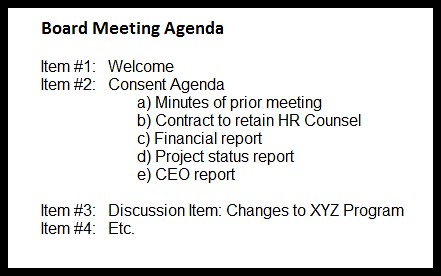Want to free up your board’s time to talk about making a difference in the community? The easiest way to do that is to use a Consent Agenda.
A Consent Agenda is a tool that can eliminate as much as ½ hour or more of reviewing what has happened in the past – things the board can do nothing about – and thereby make room for your board to talk about the things they can actually impact (i.e. the future).
The consent agenda is a single item that combines all the things the board would normally approve with little comment. The minutes. The financials (yes, the financials!). Program reports or CEO reports. Perfunctory items such as formal approval of a contract that has already been talked to death at past meetings.
All those items combine to become one item for approval – The Consent Agenda.
Your board’s agenda might therefore look like this:

As a single item on the agenda, the consent agenda is voted on with a single vote – to approve the consent agenda. The key to the Consent Agenda’s effectiveness, though, is that there is NO DISCUSSION of that item!
That’s right. All those things that would have taken 2 minutes here, 5 minutes there, 1 minute here – they are off the table in one vote. The vote sounds like this:
Mary: I move to approve the consent agenda.
Ann: I’ll second that motion.
Chair: All in favor, signify by saying “Aye.”
That’s it. NO discussion. And all those items that previously took ½ hour or more have now all been approved.
Because there will be no discussion of these items individually, using a consent agenda requires that board materials be provided in plenty of time for board members to read them all. AND it requires that they read those materials!
Handling Items That Require Discussion or Clarification
Sometimes a board member will have a question he would like answered before he votes. Or he feels the issue still requires discussion before he would feel comfortable voting. Those are two distinct scenarios, and they receive two distinct treatments.
Items for Clarification or Questions
An item should not be pulled from the consent agenda just to have a question answered. That sort of information gathering should happen ONLY before the meeting.
There are two reasons for this.
1) This allows time to gather the information. (There is nothing worse than having an issue tabled for the next meeting, only because a question could not be answered then and there.)
2) That clarification can now be sent to all board members, so everyone has the same information before the meeting.
Items for Discussion
If there is an item about which a board member disagrees, or believes that item requires discussion, then a request is made to pull that one item from the Consent Agenda and to add it to the regular agenda. The remainder of the Consent Agenda items are voted on and approved, and only that single item is held out for discussion.
“Ms. Chairwoman, I would like to request that the Item ‘C’ be pulled from the Consent Agenda for discussion.”
“All in favor of approving the Consent Agenda, minus Item ‘C,’ signify by saying Aye.”
Then Item ‘C’ will be discussed as a regular discussion item.
The Results
As a result of using a consent agenda, you will learn and your board will grow. First, you will learn that much of what you have been spending time on at board meetings is either perfunctory or has already happened and is therefore nothing the board can do anything about. That is often an eye-opener for a board.
But then, your board will have room to grow. You will have time to discuss the only thing that matters – the results you want to see in the community. The difference you want to be making. The values and parameters that will guide that work. The various ways you want to engage the community in that work, and the reasons for that engagement.
That is Governing for What Matters. It is a board holding itself accountable first for the end results it wants to see in the community, and then for the means for accomplishing that.
And the best result of all? Your board meetings may actually become fun.

Good work. At first I was worried it was “earmarking” or packaging a bunch of good items with a crappy one just to get it to pass, but the subtlety here is just getting people to do their jobs before the meeting or after their meeting, as opposed to during the meeting in a half-assed and careless manner that essentially wastes everyone’s time and drains any possible spirit out of the meeting. Brilliant.
the only thing that makes a bad meeting bearable is a big tray of baked goods and a hug tank of coffee, and that’s no way to live.
I’m in DC now and the word consensus scares the pants off of boards. Good job.
-casey.
My mayor & city council use the consent agenda to fill vacancies, buy the police dept. a new vehicle & numerous others things that are NOT routine items. When I complain about it I’m told I should have requested it be pulled. My argument is it shouldn’t be there in the 1st place. We deserve to have some input into these items